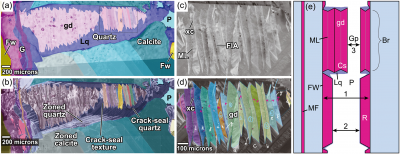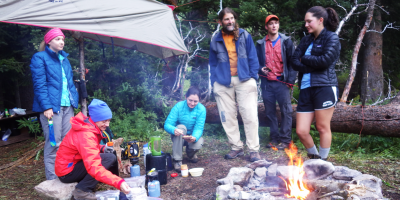Structural diagenesis is a new perspective on the interaction of mechanical and chemical processes at high crustal levels in the Earth. The roots of a structural diagenesis prospective are in research projects that have been in operation in Austin for more than two decades.
Fracture and fault studies primarily rely on structural observations and interpretations based on mechanics. And rigorous structural observations and application of fracture mechanics continue to yield important insights. But for understanding fractures and faults in the deep subsurface of sedimentary basins (1 to 10 km), structural geometry and mechanics by themselves provide an incomplete picture. In the presence of hot, reactive fluids like those found at greater depths in the Earth, chemical reactions are an essential consideration. Although sedimentary petrologists typically study chemical reactions that convert sediment to rock—diagenesis—they generally neglect fractures and faults. Structural geologists on the other hand typically do not receive intensive training in sedimentary petrology.

Examples of structural diagenesis. Reviews of Geophysics figure 7.
Starting in the late 1980s, researchers in Austin and elsewhere recognized that a key to unlocking scientific knowledge about postdepositional structural processes in sedimentary basins is research that relies on principles of both structure and diagenesis (or chemical change). The implications were developed in publications over the years, but a ramp up was a major project funded by Bill Fisher in the first years of the Jackson School.
The Jackson School’s seed led to considerable external funding, and the Structural Diagenesis Initiative (SDI) continues as a community of researchers, teachers, and students.
SDI research led to breakthroughs in fundamental fracture and fault problems. Some of these contributions were recognized by a ‘best research’ award from Basic Energy Sciences in 2004 and some contributions are described in a recent Reviews of Geophysics paper.
At about the time the Jackson School-funded program got underway, and increasingly as the program prospered with Basic Energy Science and industry support, the importance of changing the geoscience training paradigm for brittle structural geology became evident. A 2010 Journal of Structural Geology paper proposed the merger of disciplines and a new training regimen for sedimentary geochemistry and structural geology.
Among those involved the structural diagenesis movement are Stephen Laubach, Jon Olson, Rob Lander, and Randy Marrett. Their interests cover a large part of the structural diagenesis spectrum; structural geology, mechanics, and diagenesis. They are or were principal investigators for a long-running DOE Basic Energy Sciences grant on predicting fracture porosity evolution in sandstone and central contributors to the industry sponsored Fracture Research and Application Consortium (FRAC). The scope of these projects ranges from the fundamental to the intensely practical, but they share the theme of linked mechanical and chemical processes.
Recent papers by Weisenberger et al. and Almansour et al. illustrate this broad scope. These papers treat the issue of calcite accumulation in fractures in sandstone. But Weisenberger et al. explore the fundamental physical processes that controls calcite accumulation, whereas Almansour et al. investigate the deeply pragmatic issue of valuing information and making development decisions based on observations of calcite deposits. But as the Almansour et al. paper points out, the practical application stands on the insights provided by the research on fundamental processes. The papers are accessible from the Publications page and are discussed in a separate blog post.
In their different ways, both the BES project and FRAC seek to better understand how natural fractures grow in the Earth in order to improve resource production in oil and gas reservoirs and for other practical applications.

Students and faculty from the SDI community in the field
The Austin’s Structural Diagenesis community, including Laubach, Olson, Marrett, Linda Bonnell, Peter Eichhubl, Sara Elliott, Andras Fall, Julia Gale, Peter Hennings, Kitty Milliken, Rob Reed, and Esti Ukar, have been highly productive contributors to the scientific literature.
And the quality of the work has been recognized with various best paper awards and distinguished lecture tours. Some of these are listed on the Distinguished lecture page.
The Austin SDI community continues to grow. Nicholas Espinoza, Masa Prodanovic, Michal Pyrcz, Rich Schultz, and Nicola Tisato are recent contributors. And the worldwide community is expanding, including Chris Hilgers and Juliette Lamarche in Europe.
Much of the initiative’s success is attributable to mentored students and their research and publications. Current University of Texas 2019 graduate students include Rodrigo Correa, Natchanan “Mint” Doungkaew, Stephanie R. Forstner, Gabriel Gallardo Giozza, Bethany Rysak, Mahmood Shakiba, and Qiqi Wang. See the student information page for a list of present and past students and postdoctoral fellows.
Notable recent 2019 student publications include papers by Almansour et al. in SPE Reservoir Evaluation & Engineering, Callahan et al. in JSR Solid Earth and in Geothermics, Denny et al. in GSA Bulletin, Ramos et al. in Geophysics and in Geophysical Journal International, Wang et al. in Petroleum Geoscience, and Yue et al. in SPE Drilling & Completions. For links to these papers, see the Publications page.
And earlier Texas students from the program are now leading the way at other institutions, like Peggy Rijken, named a distinguished alumna of PGE, program chairperson for the 2019 SPE Annual Technical Conference & Exhibition, who works for Chevron, Kan Wu, Professor at Texas A&M, Owen Callahan, now a postdoctoral fellow for CISR, and student and former Bureau researcher John Hooker, now at the Department of Geosciences at Penn State University.
Graduate students, postgraduate and full-time researchers, and faculty worldwide are also eligible for an award that promotes structural diagenesis research. The aim is to promote research combining structural geology and diagenesis, and curriculum development in structural diagenesis. To help promote the cross disciplinary emphasis of this annual award, the Sedimentary Geology and Structural Geology & Tectonics Divisions of the Geological Society of America have been designated to jointly select the recipient. The responsibility for the award alternates between the Sedimentary Geology Division and Structural Geology & Tectonics Division.
The GSA S&T Division web site provides further information about the award, including how to apply.
This award supports studies of fracturing and the diagenetic processes, such as cement precipitation and dissolution, that govern the geomechanical evolution of diagenetically-altered fractured sedimentary rocks. The award highlights interdisciplinary techniques in structural geology and sedimentary petrology, and their applications in recovery of resources and sequestration of material in sedimentary basins.
The Austin structural diagenesis community celebrates research progress and builds cross-disciplinary and cross-unit collaborations though an annual picnic, usually held in the Fall. The gathering is open to anyone sharing a research or teaching interest in this emerging field. If you think you might be interested, or if you just like BBQ and fireworks, contact Steve Laubach.
More information about the scientific goals and accomplishments of Austin’s Structural Diagenesis Initiative can be found in these papers:
- The role of chemistry in fracture pattern development and opportunities to advance interpretations of geological materials. Laubach, S.E., Lander, R.H., Criscenti, L.J., et al., 2019. Reviews of Geophysics, 57 (3), 1065-1111. doi:10.1029/2019RG000671 | view | blog post | BEG summary | view AGU Editor’s Vox | JSG press release
- Structural diagenesis. Laubach, S.E, P. Eichhubl, C. Hilgers, R.H. Lander, 2010, Journal of Structural Geology 32 (12), 1866-1872. doi:10.1016/j.jsg.2010.10.001. | view
© 2025 Jackson School of Geosciences, The University of Texas at Austin


